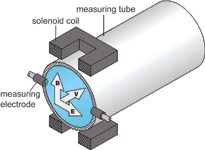

Magnetic inductive flowmeters use Faraday’s law of inductance to measure flow rates in electrically conductive fluids. Other technologies used to measure flow rate include paddle wheel, vortex and variable area tubes, but unlike these devices, magnetic inductive flowmeters do not disrupt the flow to obtain their readings. This is important because it results in virtually no pressure loss in the system and no chance of contaminating the flow in the event of failure. When pressure in the system increases, pumps need to be larger in size and use more electricity than if pressure is less and flow is unrestricted.
Principles of operation
A magnetic inductive flowmeter consists of a solenoid coil, measuring tube and electrodes. Faraday’s law of induction, ie, the law of electromagnetic induction, states that a wire entering a magnetic field will induce a voltage. In the case of magnetic inductive flowmeters, the wire is replaced by electrically conductive fluids, as electrically conductive fluids have the ability to carry charged particles. The meter’s solenoid coil produces a magnetic field and when the charged particles enter the magnetic field they are driven to the outside of the tube wall. This creates a potential energy difference (voltage) which is measured by the electrodes in the meter. Faraday’s law states that the voltage generated by the conductor is proportional to that conductor’s velocity, multiplied by the length of the conductor, multiplied by the strength of the magnetic field.
Since the strength of the magnetic field and length of the conductor is known, the velocity is easily calculated from the voltage generated. For example, if fluid travelling at speed x produces voltage y, then the same fluid travelling at 2x will produce voltage 2y. Faraday’s law is not dependent on temperature, pressure, viscosity or density – the potential energy difference is proportional to the flow rate.
Types of media sensed
In order to apply a magnetic inductive flowmeter, the fluid must be electrically conductive. Just like copper is a better conductor than iron, some liquids are better conductors than others. Tap water, for instance, is a great conductor. However, de-ionised water is an insulator and cannot be detected by magnetic inductive flowmeters. Liquids that have little or no conductivity, such as hydrocarbons, oils and non-aqueous solutions, cannot be used with magnetic inductive technology.
Conductivity
* Not all water is the same. Since water contains different amounts of total dissolved solids, ions and metals, the conductivity will also vary. De-ionised, distilled and other purified solutions used in pharmaceutical and chemical industries are generally not conductive, and therefore will not work with magnetic inductive flowmeters.
* Conductivity varies with temperature. The temperature of the fluid should be known to determine if its conductivity meets the meter’s minimum requirements at the operating temperature.
* Concentration also affects conductivity. In general, conductivity rises with concentration, but only up to a point. In many acidic and caustic solutions it decreases after 20% or so.
Viscosity
* In general, viscosity has no effect on the flowmeter. The flow rates for grease/liquid and sludge should be kept high enough so the fluid does not coat the inside of the meter.
Density and fluids with particles
* Magnetic inductive meters are not affected by fluids containing debris and solids suspended in the flow. Since the solids are moving at the same rate as the conductive liquid the flow rate is accurately measured. Also, density of the fluid is not a factor in determining flow rate. In paddle wheel, vortex and variable area tubes, debris, solids and very dense fluids could inhibit operation of the sensor.
Some magnetic inductive flowmeters offer a few advantages over other available models. Select meters are self contained units, ie, the controlling electronics and flow measuring device is one unit. Other sensors are often larger in size and are sold as two separate pieces, the flow measuring unit and electronic controller. Some manufacturer’s offer a variety of materials for the sensor and probe tips. The main advantage of magnetic inductive flowmeters is the ability to measure flow independent of pressure, temperature, density and viscosity.
For more information contact Rodney Topham, RET Automation Controls, +27 (0)11 453 2468, [email protected], www.retautomation.com
| Tel: | +27 11 453 2468 |
| Email: | [email protected] |
| www: | www.turckbanner.co.za |
| Articles: | More information and articles about Turck Banner Southern Africa |

© Technews Publishing (Pty) Ltd | All Rights Reserved